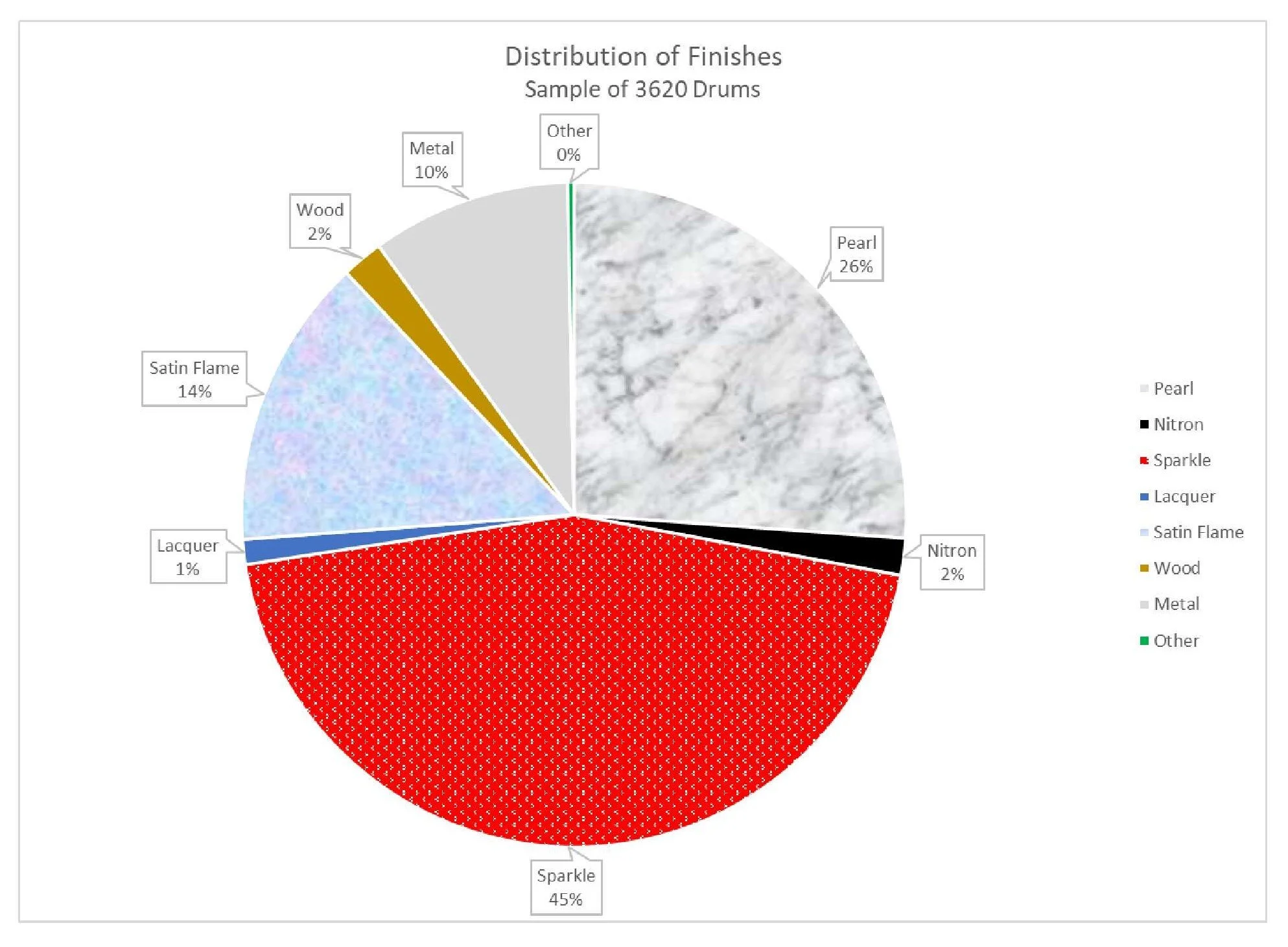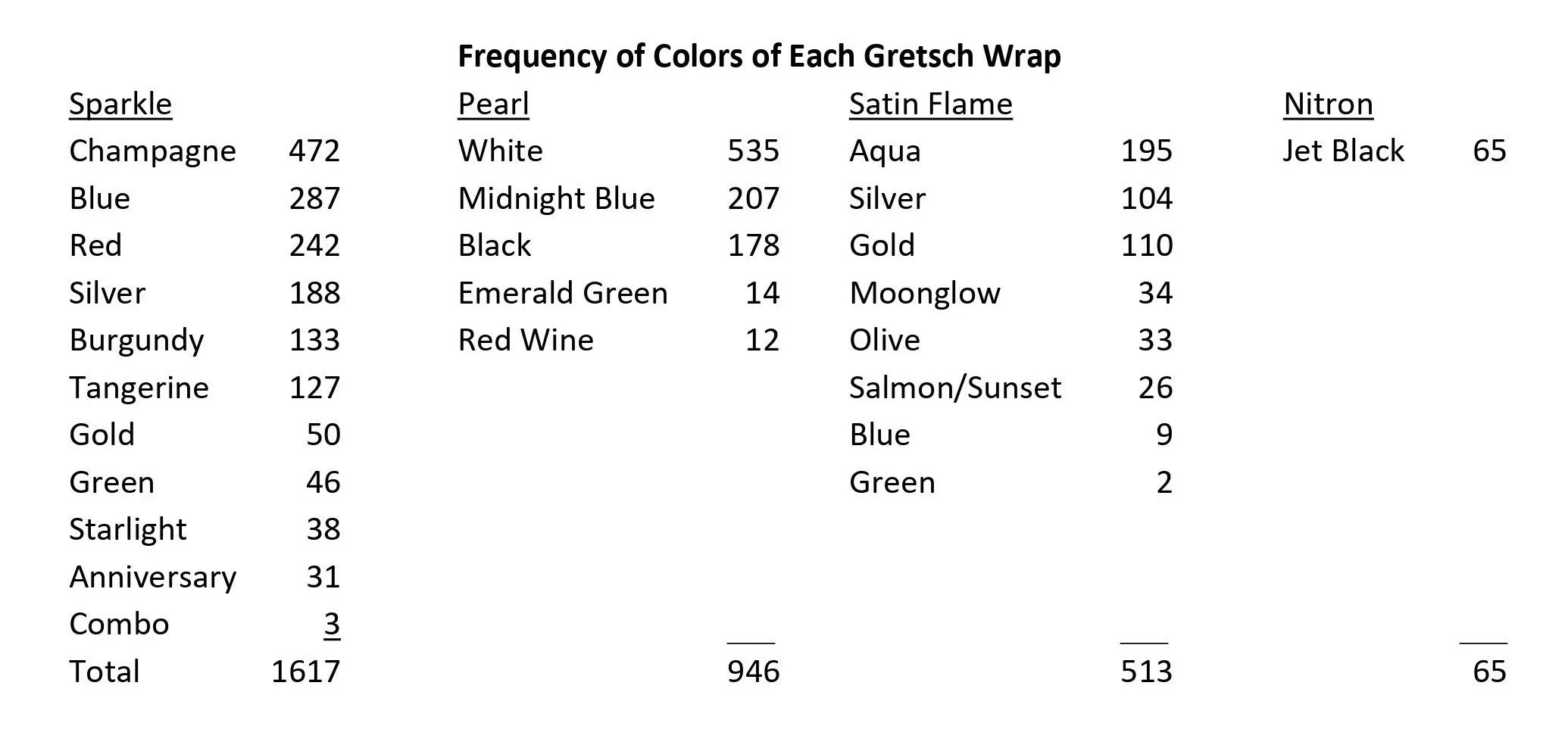Just how common are the various wraps and finishes that Gretsch used on its vintage drums? This study reviews data gathered from a representative sample of Round Badge Gretsch drums produced from about 1962 through about 1969. It considers only those with paper labels with serial numbers, as the combination of paper label (introduced in about 1962) and round badge (discontinued about 1969) provides well-defined boundaries and the database used for this study was originally compiled to study serialization of Gretsch drums.[i]
A total of 4,072 drums with round badges and serial numbers makes up the study data set. Four hundred and fifty-two drums are disregarded because they are acknowledged or determined to be rewrapped or refinished, or their finishes cannot be definitively determined. The remaining 3,620 drums are sorted by finish and analyzed.
Overall Distribution of Finishes:
The total number of drums with each finish is provided below:
About 86% of the drums Gretsch produced during the study period are wrapped, wood shelled drums. The wrapped drums are divided between Sparkle[ii] (45%), Pearl (26%), Satin Flame (14%) and Nitron (2%) wraps. Gretsch also produced metal shelled snare drums (10%), a number of both stained (2%) and painted (1%) wood shelled drums and a small number of other finishes (<1%).
The distribution of finishes is shown graphically below:
The number of drums of each wrap and color are provided below:
Sparkle Wraps:
The Sparkle finishes are broken down by color, with Champagne (29%) the most prevalent, followed by Blue (18%), Silver (15%), Red (12%), Tangerine and Burgundy (8% each), Green and Gold (3% each), and Anniversary and Starlight (2% each). There are also a small number of drums with more one color of wrap (<1%). The distribution of Sparkle wraps by color is shown graphically below:
Note that some drums described by their owners as Tangerine may have been Red but it is difficult to determine for certain due to poor pictures or fading issues. Several drums described by their owners as Orange are included with the Gold totals because the Gold Sparkle wrap looks Orange.
Most of the colors of Sparkle wraps were available throughout the study period. Anniversary and Starlight Sparkle are shown in earlier catalogs but a few examples appear during the earlier years of the study period.
Pearl Wraps:
The Pearl wraps are broken down by color, with White (57%) the most prevalent, followed by Midnight Blue (22%), Black (19%) and Red Wine and Emerald Green (1% each). The distribution of Pearl wraps by color is shown graphically below:
Pearl wraps are almost all in three colors - White (aka White Marine Pearl), Midnight Blue (aka Light Blue Pearl) and Black (aka Black Diamond Pearl). Red Wine and Emerald Green Pearl were introduced during the final year or so of the Round Badge era. These last two colors are seen more frequently in Stop Sign Badge drums.
Satin Flame Wraps:
The Satin Flame wraps show a large number of different colors, some of which are not shown in catalogs of the era. The most common color of Satin Flame wrap is Aqua (38%), followed by Gold (22%), Silver (20%), Moonglow and Olive (7% each), Salmon/Sunset (5%), Blue (2%) and Green (<1%). The catalogs from the era showed Aqua, Gold, Silver options, while early 1970s catalogs showed Moonglow and Peacock as well. There were no examples of Peacock Satin Flame wraps in the study group. Several of the colors in the study did not appear in catalogs at all - Olive, Salmon/Sunset, Blue and Green. One problem with non-cataloged colors is that vintage drum enthusiasts do not always use the same name for them. For example, one non-cataloged color is known as both Salmon and Sunset. Catalogs have not proven to be completely accurate historical records regarding what colors of finishes were available during a particular time frame. Gretsch Satin Flame wraps are a particularly good example of this situation.
The distribution of Satin Flame wraps by color is shown graphically below:
All 65 of the Nitron wrapped drums were Jet Black in color, so no graph of Nitron Wraps is provided.
A few notes of caution when considering these results:
1. Although this study only involved 3,620 of the about 116,000 (3.1%) Round Badge drums with serial numbers, it appears to be a fairly representative sampling of the distribution of finishes and colors used by Gretsch in the 1962-1969 time period. Finishes during earlier and later time periods likely differ considerably.
2. The number of wrapped drums is likely underrepresented, as many drums had wraps removed for rewrapping or refinishing without wraps. Four hundred and fifty-two (452) drums were excluded from the analysis. If they are all considered as originally wrapped, that would push the total of wrapped drums to 3,573, representing 88% of 4,072 drums studied.
3. Although efforts are taken to exclude drums which appear to be rewrapped or refinished from this study, but some drums may be included which do not display their original finish.
4. Metal shell drums do not have the potential for having their wraps removed, so their numbers are considered to be very reliable.
[i] More information on vintage Gretsch serial numbers available at Richard E. Gier, Dating of Vintage Gretsch Drums Based Upon Serial Numbers – Challenging the Legend, Lore and Lies, Rebeats Publications, Alma, MI, 2011.
[ii] Certain colors are generally seen in the study period as Glass Glitter (irregular shaped particles) and others as Sparkle (hexagonal shaped particles). Both are presented in catalogs of the era as Sparkle finishes, so that name is used in this study.






